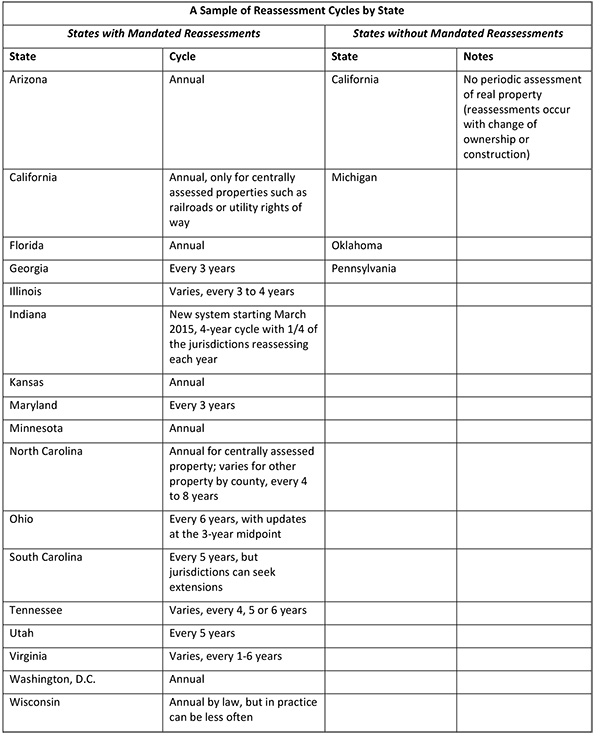A recent legal change in Indiana has created a model for property tax reform across the country. Starting in 2011, the Hoosier State has compelled assessing officials to defend excessive assessment increases with objective evidence and meaningful arguments in appeals.
The statute applies whenever the appealed property's value has increased by more than 5 percent over its prior year's value. Moreover, where the prior year's value was reduced on appeal and the reduction was not based on the income approach, the assessor now has the burden of proof to support any increase. Failure to defend the assessment automatically reduces the property's assessment to the prior year's level, and the taxpayer can press to further reduce the value.
Assessors on the defensive
This simple change gives Indiana taxpayers greater protections in appeals than taxpayers have in most other jurisdictions. Why? With no burden of proof on appeal, an assessor may contend that her value is presumed correct. Instead of explaining how she derived a property's value, the assessor may attempt only to discredit the taxpayer's case.
With the burden of proof, however, the assessor must produce probative evidence and logical arguments to support her value. She must explain why her assessment meets the jurisdiction's valuation standard. She must walk the local or state tribunal through her analysis. In short, she must explain how she did her job and produce evidence justifying her increased valuation.
An assessor that fails in those steps will likely lose. To avoid the time, expense and potential embarrassment of a loss, the assessor who carries the burden of proof is more likely to settle a case.
Limits on burden-shifting
For the burden-shifting statute to apply, the property under appeal must be the same property for both the current and prior years. It does not apply where the disputed assessment is based on structural improvements, zoning or uses that were not considered in the assessment for the prior tax year.
If significant new construction or demolitions occur at the property between the prior and current assessment dates, the taxpayer maintains the burden of proof. If the increase in value is due to the assessment of omitted property, such as when the assessor added square footage previously overlooked, then the taxpayer maintains the burden of proof.
The burden-shifting statute applies only to an increase of assessed value, not to an increase in tax burden. Taxpayers carry the burden of proof to show the value should be lower than the prior year's value.
The burden of proof can shift several times during an appeal. For example, assume that an Indiana commercial property is assessed at $800,000 in Year 1. In Year 2, the assessment increases by more than 5 percent to $1 million.
The property's physical status and use are the same in both years, and the taxpayer has an appraisal supporting a value of $500,000 in Year 2. The assessor carries the initial burden of proof to show her $1 million value is proper. If she fails to make a convincing case, the property's assessment will at minimum revert to its Year 1 value of $800,000. The taxpayer then has the burden of proof to show that its appraised value of $500,000 is correct.
If persuasive, the appraised value likely will carry the day; the Indiana Tax Court has said that an appraisal compliant with the Uniform Standards of Professional Appraisal Practice is often the best evidence of value. Even if the appraisal is unpersuasive, the property's assessment will still be lowered to its Year 1 value.
What are the drawbacks?
Who has the burden is sometimes unclear, so deciding the burden of proof may add an argument to the appeal. Parties may file motions in advance of a hearing to decide the burden of proof issue. If multiple years are under appeal, different parties may (depending on the values from year to year) have the burden of proof for different years, which could complicate the presentation of arguments and evidence at the administrative hearing.
The burden-shifting statute is one reason that more assessors are hiring counsel and paying for appraisals in appeals, which might prolong the appeals process in some cases. Taken as a whole, however, Indiana's burden-shifting experience has been a positive one for taxpayers. Taxpayers have always had to present evidence and arguments to prevail and now, in many cases, so do the assessors.
Indiana has compelled assessing officials to explain how they did their jobs correctly—or lose on appeal. Assessors who can't or won't defend their assessments are more likely to settle, saving taxpayers considerable time and resources. Taxpayers in other states should consider pressing lawmakers in their jurisdictions to replicate this Heartland property tax experiment.











